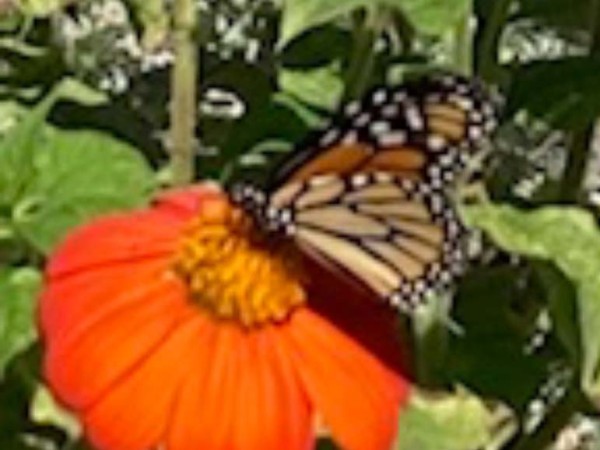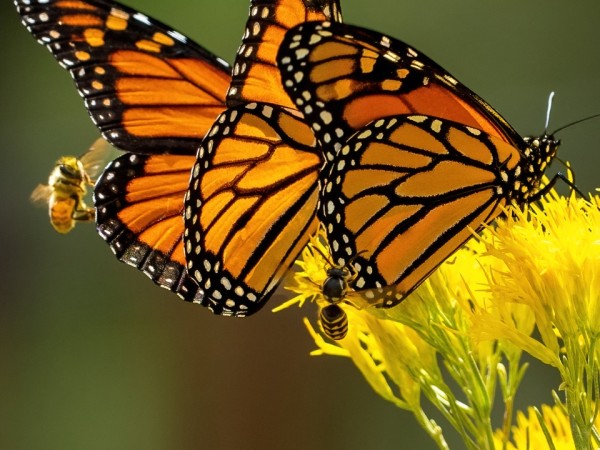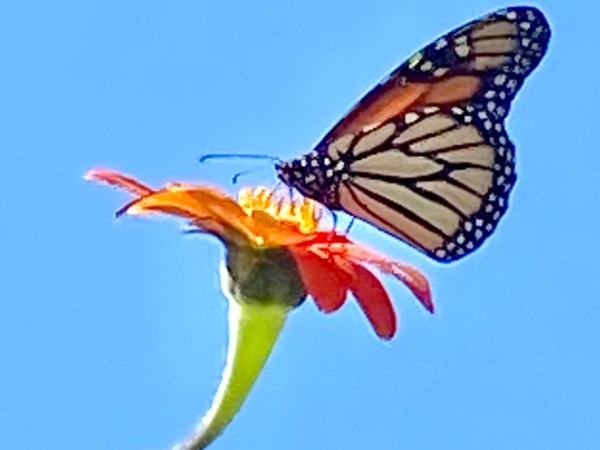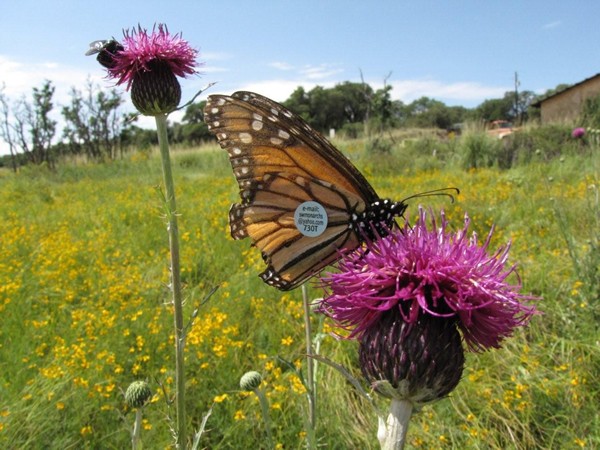Letter From Gail Morris: Western Monarch Fall 2023 Report #2
published: 10/02/2023
Western Monarchs Update
Monarchs stretched across the Western States as their fall migration continued. They have been seen stopping to nectar on native sunflowers and rabbitbrush across the land but have also visited tithonia and butterfly bush in urban yards to refuel. Favorable temperatures and winds are helping them on their way.
Monarch Sightings
Here are a sample of recent monarch sightings. Be sure to check out our live maps of monarch sightings as they are reported to see where monarchs are now near you!
Patti in Portland, Oregon, reported on September 26, “Photo is cut off but there are two monarchs nectaring on tithonia.”
Karen in South Lake Tahoe, Nevada, saw four monarchs on September 25. “These were nectaring on what I believe are rubber rabbitbrush.”
Susan in Mill Valley, California, also reported 2 monarchs this week on October 1. “We’ve seen them all over this Tithonia during the past 2-3 weeks. They look bright and fresh.”
Martina in Ogden, Utah, saw 2 monarchs on September 27. “2 Monarchs nektaring. 25 Celsius, no wind, full son [sic].”
Claudia in Peoria, Arizona, found 1 monarch in her yard on September 23. “Male Monarch, 9-23-23, like new condition with no damage of any kind and very active. Initially seen at 3:14pm, temperature 95 degrees, no wind... flying all over pollinator garden landing on A. subulata milkweed, Blue Mistflower, and resting in trees in the company of 2 Queens. Never landed long, so difficult to photo… very skittish to any movement at all. at 5:00 pm, still in the garden. First Monarch seen this Fall in my garden.”
Peak Migration in the West
Monarch butterflies east of the Rocky Mountains are more plentiful and often seen in clusters as they make their way south to overwinter in Mexico. Often cooler night temperatures hasten their flight on the way. As we all know, there are smaller numbers of monarchs in the West, so how can we label, “Peak Migration?” Scientists are still discerning the parameters, but one way we can help as Community Scientists is to note when we begin to see multiples in an area instead of just one.
How this may happen may vary. For example, you may find 4 or 5 monarchs one morning feeding on sunflowers in your yard when earlier you’ve only seen one. Or, maybe you are working outside one morning and notice a series of single monarchs coasting in and feeding on nearby rabbitbrush — and then taking off once again to the south. Then a few minutes later another arrives, beginning a stream throughout the day. Total up how many monarchs you see and their favorite nectar source(s), and let us know. What a beautiful nature treat for you to witness on what likely began as just an ordinary day. Every migration is unique and if you are lucky enough to see multiple monarchs, let us know at Journey North! Studies have shown that the Peak Migration moves South generally by latitude. It will ebb and flow. By December, monarchs will lose the urge to migrate.
Don’t forget to look at trees in the late afternoon, 4 p.m. and after, or in the early morning when temperatures are 50 degrees F or below. Migrating monarchs can often be found on the southeast portion of trees for the night and ready to warm up in the morning sun, especially near a favorite nectar source. Think of the benefit of a “Bed and Breakfast” roost location for hungry monarchs eager to migrate! While the splendor of large clusters in the West is more reserved to coastal California, migrating monarchs are known to loosely gather in proximity to each other in trees, especially in the Southwest part of the West if temperatures are still on the warm side. Small clusters are often composed of 6 to 10 monarchs and are reported in the lower deserts of Phoenix, Lake Havasu in Arizona, as well as the deserts of California. Be sure to take a photo and report these harbingers of the migration if you are lucky to see them.
Needed: Your Reports!
Where are monarchs in the West? You can help us. Your reports will help us all learn so much about this year’s fall migration. We need your real-time findings of monarchs in any life stage. Provide as much information as you can such as weather conditions (it’s okay to estimate), wing condition (excellent to frayed and everything in between), monarch gender, or flight direction. We look forward to your reports!
Gail Morris is the Coordinator of the Southwest Monarch Study (www.swmonarchs.org), a Monarch Watch Conservation Specialist, and the Vice President of the Monarch Butterfly Fund, the Central Arizona Butterfly Association, and the Western Monarch Advocates. The Western Monarch Population News is based on comments provided to Gail Morris. We hope to increase the number of sightings and therefore photos and comments entered into Journey North. We rely on the volunteers who communicate regularly with Gail and who agree to participate in our effort to increase awareness of the population of western monarchs. You can reach her at gail@swmonarchs.org





